Abstract
OBJECTIVES: This study describes the toxicokinetics, pulmonary function, and subjective ratings of discomfort in volunteers experimentally exposed to turpentine vapour (a mixture of monoterpenes). The results were compared with similar exposure to single monoterpenes to look in the toxicokinetics and acute effects for signs of interactions between the monoterpenes. METHODS: Eight male volunteers were exposed to 450 mg/m3 turpentine by inhalation (2 h, 50 W) in an exposure chamber. RESULTS: The mean relative uptakes of alpha-pinene, beta-pinene, and 3-carene were 62%, 66%, and 68% respectively, of the amount supplied. Between 2% and 5% of the net uptake was excreted unchanged in the expired air after the end of exposure. The mean blood clearance 21 hours after exposure (CL21h) of alpha-pinene, beta-pinene and 3-carene, were 0.8, 0.5, and 0.4 l.kg-1.h-1, respectively. The mean half lives (t1/2) of the last phase of alpha-pinene, beta-pinene, and 3-carene averaged 32, 25, and 42 hours, respectively. The t1/2s agreed with previously calculated half lives from single exposures. The total blood clearance CL21h of 3-carene found in this turpentine study was lower, and CL4h of 3-carene was significantly lower than the values obtained from similar exposure to pure 3-carene. The subjects attending both exposure to turpentine and to pure alpha-pinene at 450 mg/m3 had lower CL4h during the exposure to turpentine, when they experienced more discomfort of the throat or the airways (F = 5.7, P = 0.048) than during exposure to control concentrations. After experimental exposure to turpentine an increase in airway resistance was found that differed significantly from results of exposure to 3-carene at 10 mg/m3 (P = 0.021) or 450 mg/m3 (P = 0.047). CONCLUSIONS: Toxicokinetics and acute effects show small, if any, interactions between alpha-pinene, beta-pinene, and 3-carene. The subjects experienced discomfort in the throat and airways during exposure to turpentine and airway resistance was increased after the end of exposure.
Full text
PDF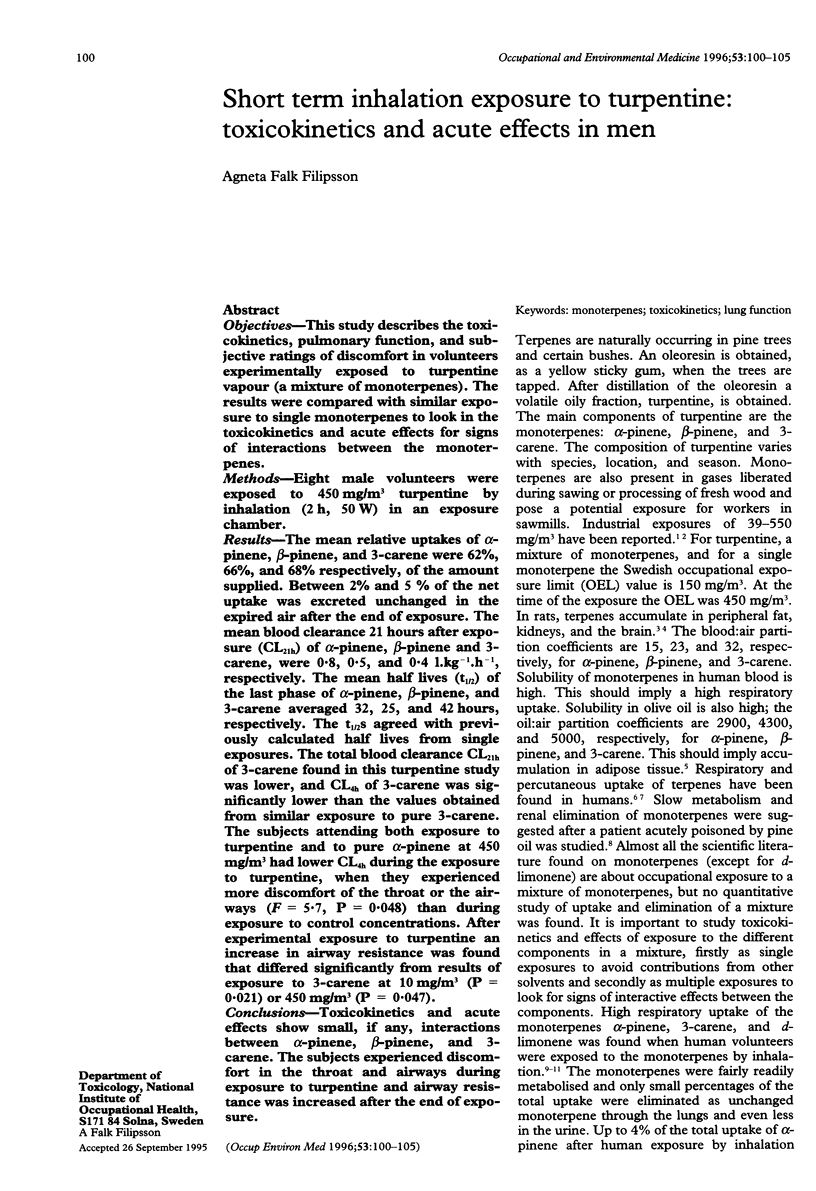
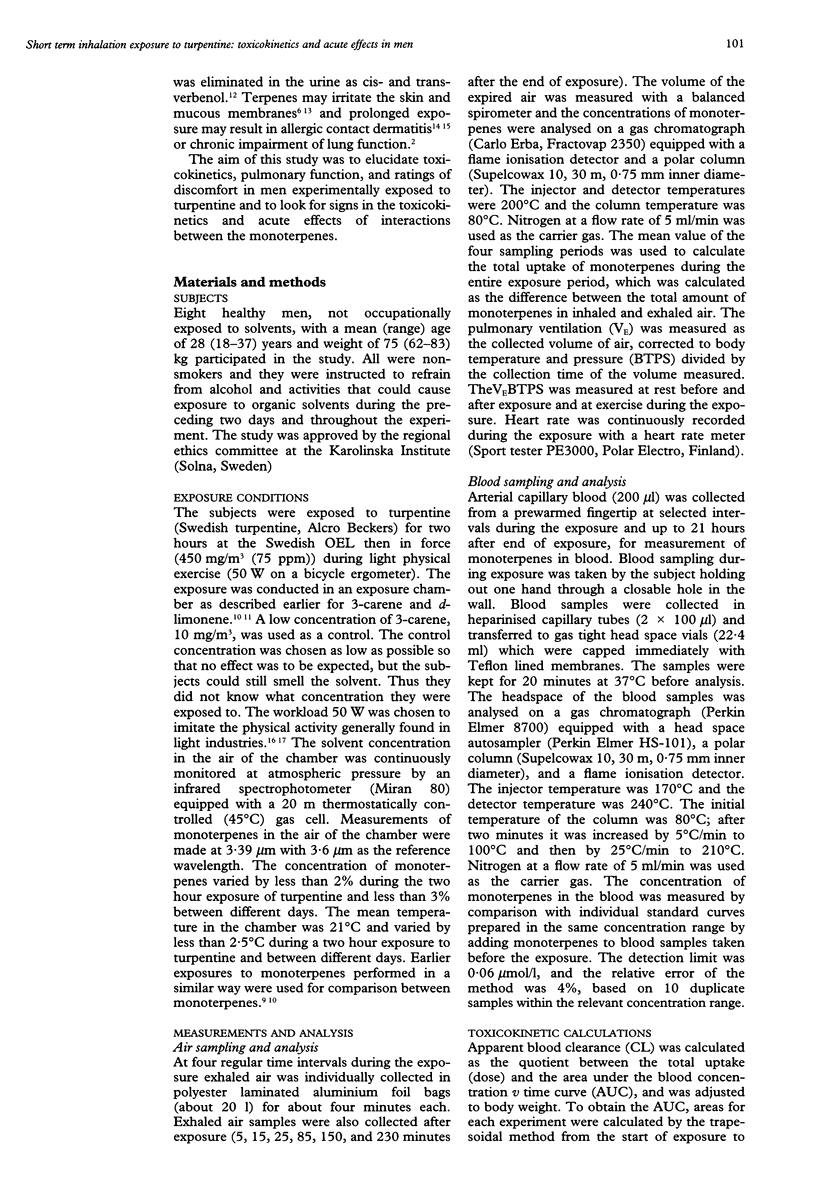
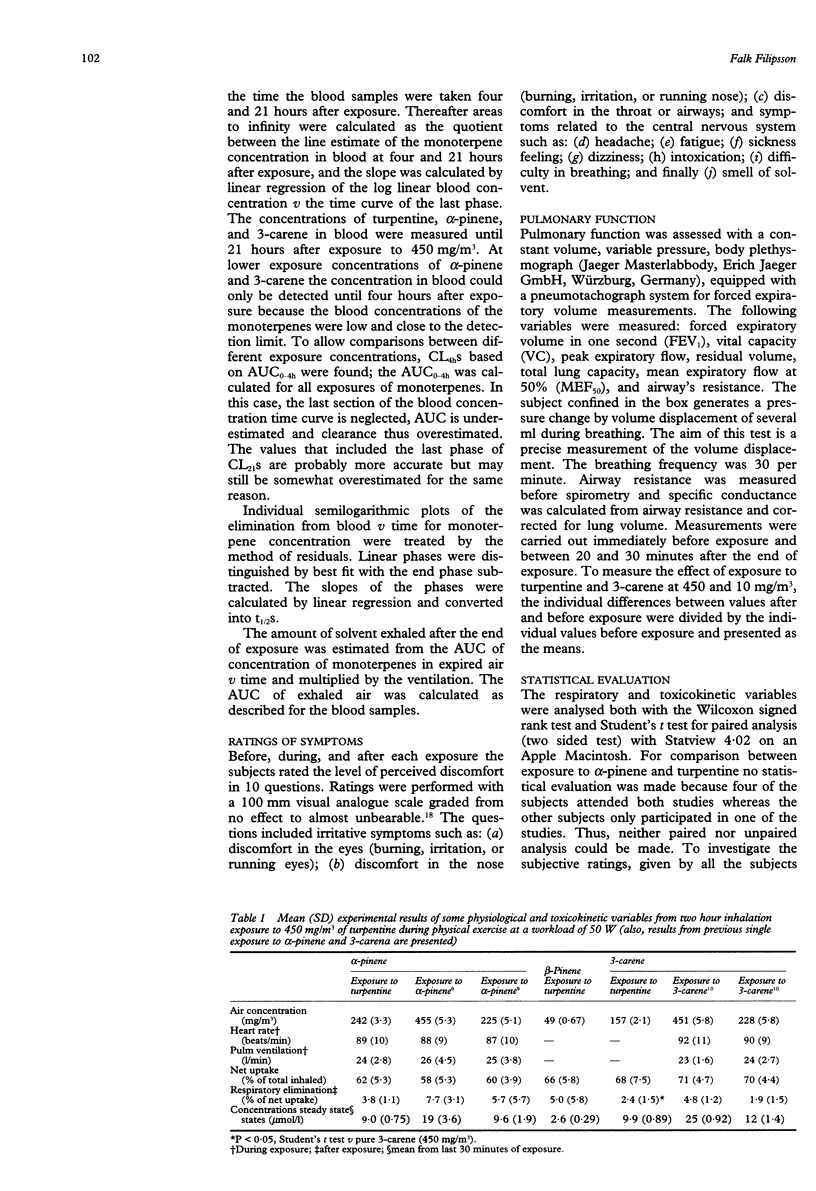
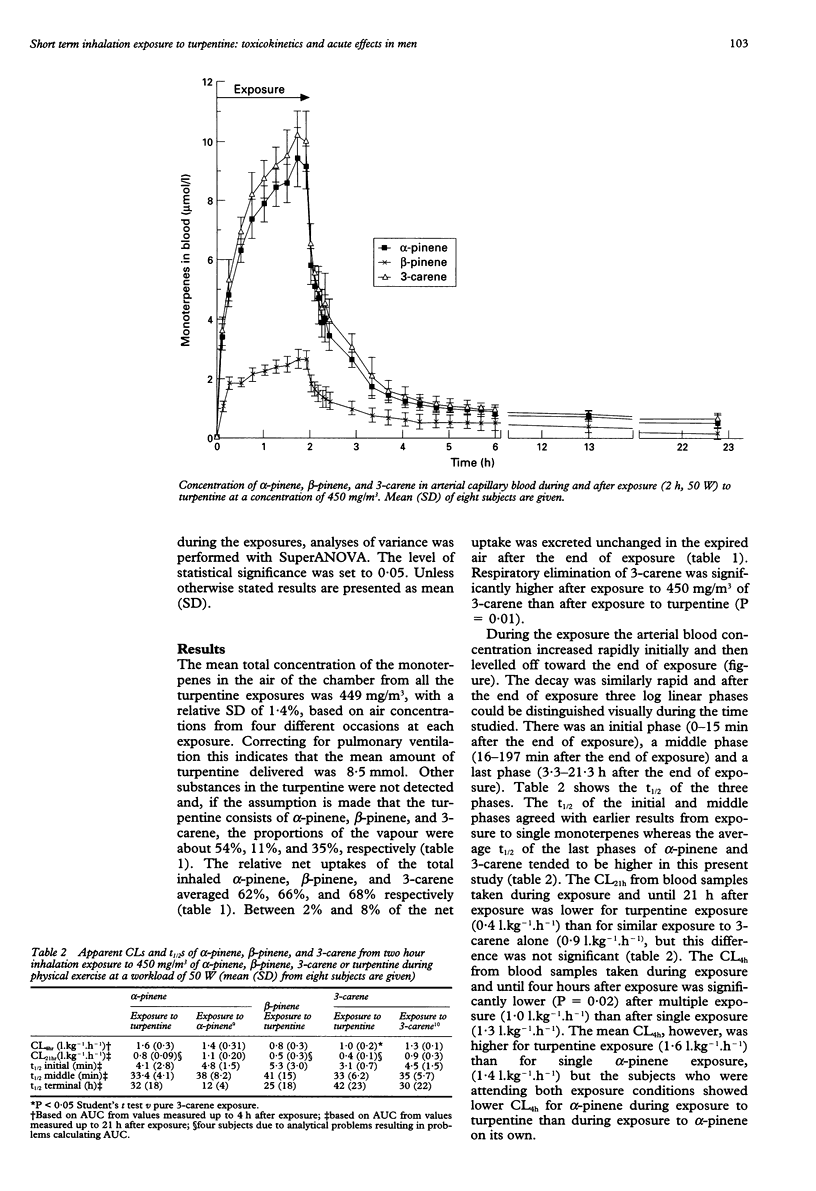
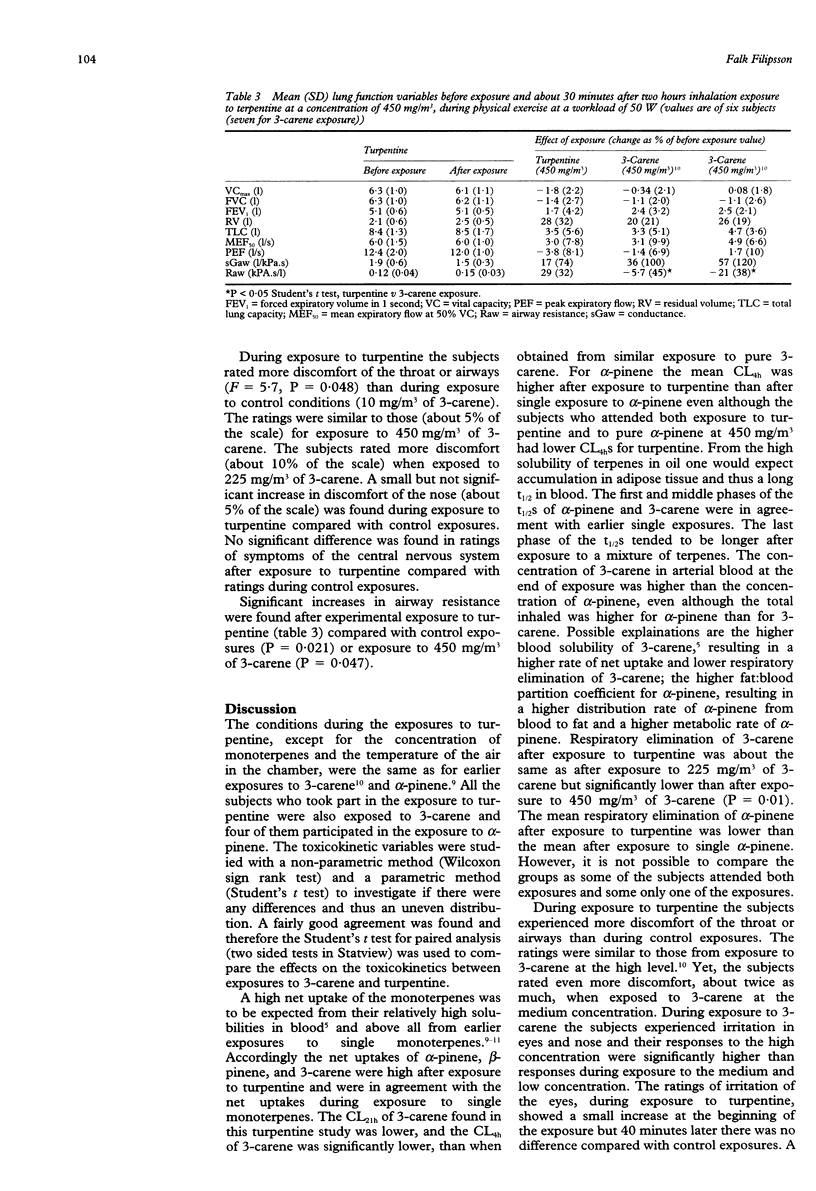
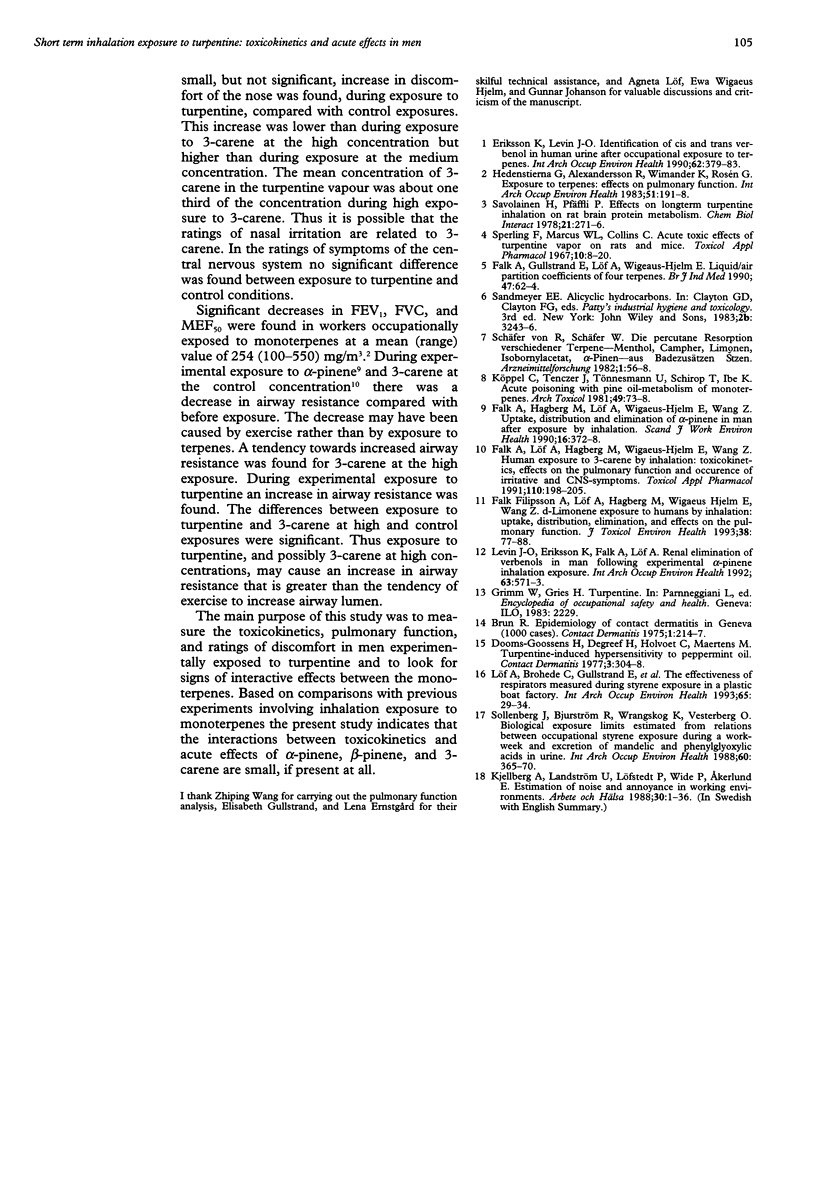
Selected References
These references are in PubMed. This may not be the complete list of references from this article.
- Brun R. Epidemiology of contact dermatitis in Geneva (1000 cases). Contact Dermatitis. 1975 Aug;1(4):214–217. doi: 10.1111/j.1600-0536.1975.tb05385.x. [DOI] [PubMed] [Google Scholar]
- Dooms-Goossens A., Degreef H., Holvoet C., Maertens M. Turpentine-induced hypersensitivity to peppermint oil. Contact Dermatitis. 1977 Dec;3(6):304–308. doi: 10.1111/j.1600-0536.1977.tb03692.x. [DOI] [PubMed] [Google Scholar]
- Eriksson K., Levin J. O. Identification of cis- and trans-verbenol in human urine after occupational exposure to terpenes. Int Arch Occup Environ Health. 1990;62(5):379–383. doi: 10.1007/BF00381368. [DOI] [PubMed] [Google Scholar]
- Falk-Filipsson A., Löf A., Hagberg M., Hjelm E. W., Wang Z. d-limonene exposure to humans by inhalation: uptake, distribution, elimination, and effects on the pulmonary function. J Toxicol Environ Health. 1993 Jan;38(1):77–88. doi: 10.1080/15287399309531702. [DOI] [PubMed] [Google Scholar]
- Falk A. A., Hagberg M. T., Löf A. E., Wigaeus-Hjelm E. M., Wang Z. P. Uptake, distribution and elimination of alpha-pinene in man after exposure by inhalation. Scand J Work Environ Health. 1990 Oct;16(5):372–378. doi: 10.5271/sjweh.1771. [DOI] [PubMed] [Google Scholar]
- Falk A., Löf A., Hagberg M., Hjelm E. W., Wang Z. Human exposure to 3-carene by inhalation: toxicokinetics, effects on pulmonary function and occurrence of irritative and CNS symptoms. Toxicol Appl Pharmacol. 1991 Sep 1;110(2):198–205. doi: 10.1016/s0041-008x(05)80002-x. [DOI] [PubMed] [Google Scholar]
- Hedenstierna G., Alexandersson R., Wimander K., Rosén G. Exposure to terpenes: effects on pulmonary function. Int Arch Occup Environ Health. 1983;51(3):191–198. doi: 10.1007/BF00377751. [DOI] [PubMed] [Google Scholar]
- Köppel C., Tenczer J., Tönnesmann U., Schirop T., Ibe K. Acute poisoning with pine oil - metabolism of monoterpenes. Arch Toxicol. 1981 Nov;49(1):73–78. doi: 10.1007/BF00352074. [DOI] [PubMed] [Google Scholar]
- Levin J. O., Eriksson K., Falk A., Löf A. Renal elimination of verbenols in man following experimental alpha-pinene inhalation exposure. Int Arch Occup Environ Health. 1992;63(8):571–573. doi: 10.1007/BF00386348. [DOI] [PubMed] [Google Scholar]
- Löf A., Brohede C., Gullstrand E., Lindström K., Sollenberg J., Wrangskog K., Hagberg M., Hedman B. K. The effectiveness of respirators measured during styrene exposure in a plastic boat factory. Int Arch Occup Environ Health. 1993;65(1):29–34. doi: 10.1007/BF00586055. [DOI] [PubMed] [Google Scholar]
- Savolainen H., Pfäffli P. Effects of long-term turpentine inhalation on rat brain protein metabolism. Chem Biol Interact. 1978 Jun;21(2-3):271–276. doi: 10.1016/0009-2797(78)90025-x. [DOI] [PubMed] [Google Scholar]
- Sollenberg J., Bjurström R., Wrangskog K., Vesterberg O. Biological exposure limits estimated from relations between occupational styrene exposure during a workweek and excretion of mandelic and phenylglyoxylic acids in urine. Int Arch Occup Environ Health. 1988;60(5):365–370. doi: 10.1007/BF00405672. [DOI] [PubMed] [Google Scholar]
- Sperling F., Marcus W. L., Collins C. Acute effects of turpentine vapor on rats and mice. Toxicol Appl Pharmacol. 1967 Jan;10(1):8–20. doi: 10.1016/0041-008x(67)90123-8. [DOI] [PubMed] [Google Scholar]


